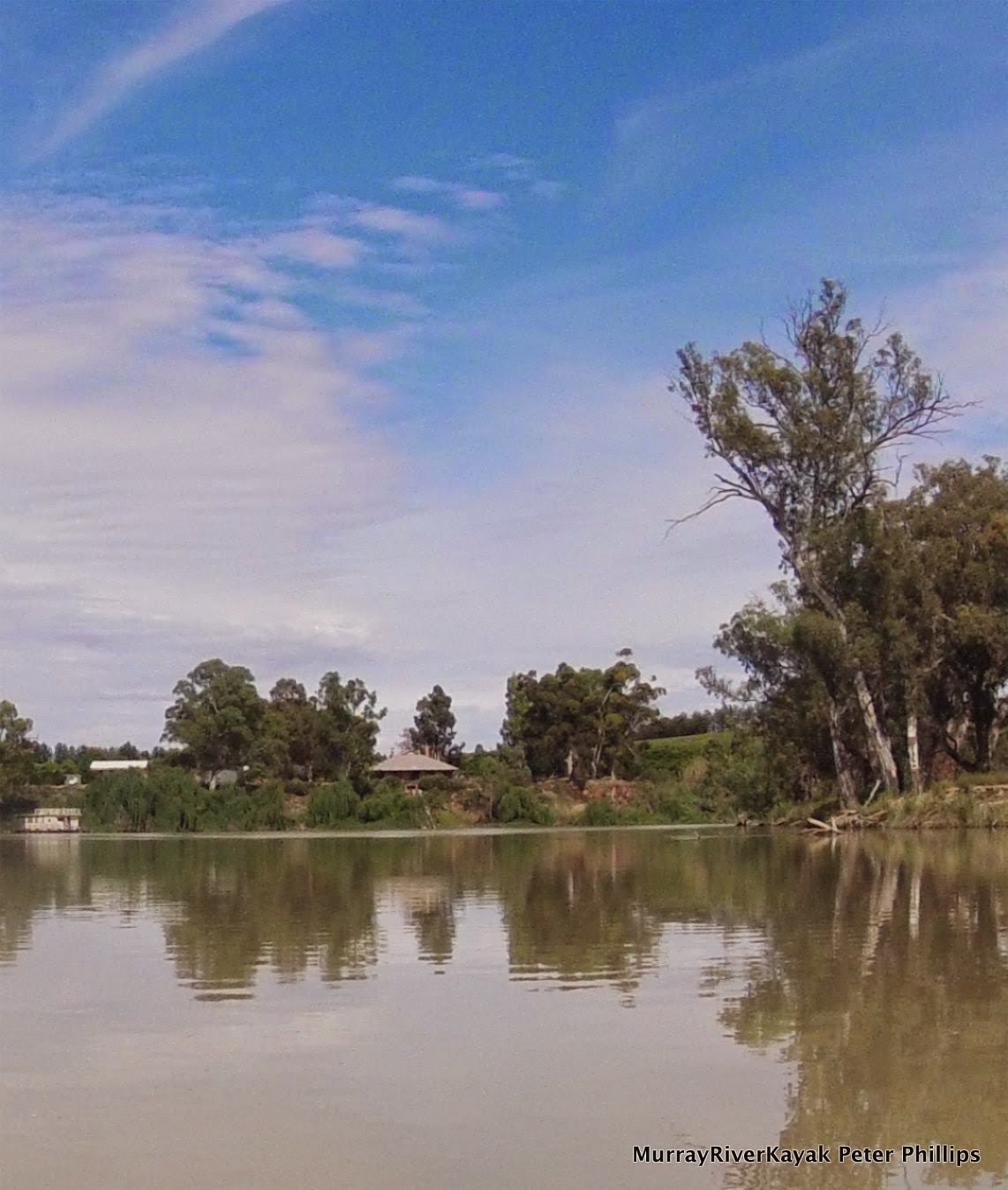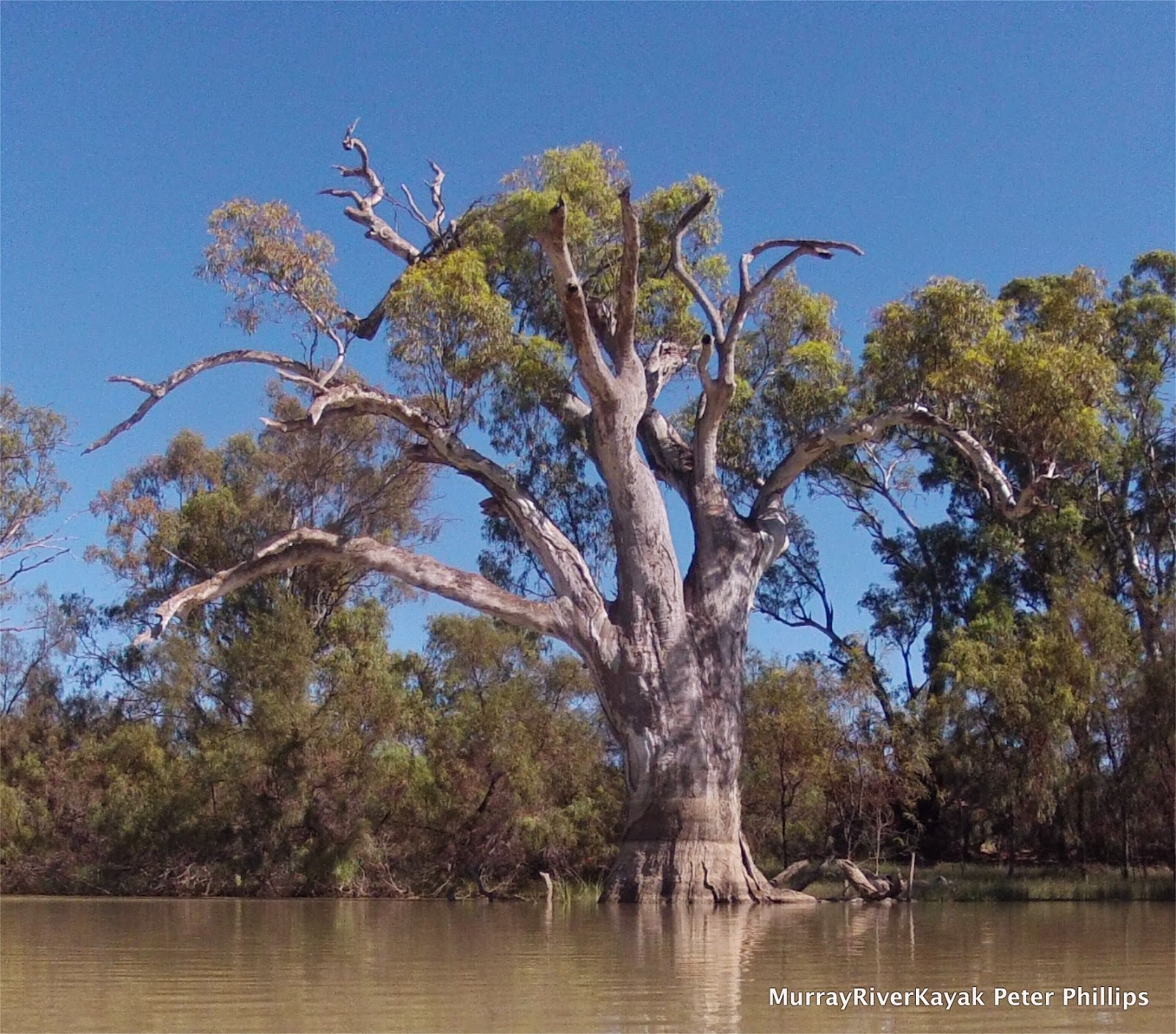Day 20: Friday 7/12
Ned’s Corner Station - Devils Elbow.
River markers: 750 to 682 km from the sea.
Distance travelled today: 68 km.
Total distance travelled: 1040 km
 |
| Day 20: Early morning reflections, Ned's Corner Station. |
Off early today. It is 7:20 am and I am about to hit the water. Morning light is beautiful and I may catch animals coming down to drink still if I am lucky :). I was camped opposite Snake Island on Ned's Corner Station property. It was true that I was tired when I pulled up, but I also could not paddle past so much beauty. I had to be a part of it. This morning's perfect reflections with Snake Island in the background were part of that experience. Pelicans are flying in formation overhead and there is still the last part of the morning chorus happening. There is no wind, but the sound of bees provides background noise, so loud that you could be forgiven for thinking they were the sound of traffic, were I in the city. The trees must be full of them.
 |
| Day 20: Celebrating 1,000km! |
In this section of river old river red gums line the banks. Behind them Mallee, box, salt bush, lignum, wattle, hakea and melaleuca create a diverse environment for a whole community of animals.
Andrew Cook, acting lockmaster at lock 9 is also a qualified shipwright. He did his apprenticeship under Kevin Hutchinson in Echuca and is currently refitting the Daisy. He has built almost all of the paddle steamers around here according to the lockmaster at lock 8. When I asked him how it is to be a lockmaster, he said that he loves it, wouldn't swap it for the world. It is stress less and you get to talk to people and everyone is friendly. He said I should call in on Peter Clark at Ned’s Corner Station. When I said that I was concerned about intruding, he answered, “Don't worry about that, this is the river, people are interested in each other, they drop in all the time. It's what we do”.
15,000 Megalitres was passing through lock 8. This is less than at lock 9 despite no major channels leaving the river in that time. This indicates that I am now pushing ahead of the main flow That is still coming down the Darling River.
 |
| Day 20: Pulled in to say "gidday" at Ned's Corner Station. |
 |
| Day 20: Trust for Nature Ranger Anthony Pay in front of his trophy wall - fox and cat tails from 2012. |
On recommendation from the lockmaster at Lock 8, I pulled into Ned’s Corner Station. Anthony Pay, a trust for nature ranger generously showed me around. Highlights were the old shearing shed, several rooms in old sheared quarters showing local history, and Anthony's trophy wall of fox and cat tails. A small railway used to lead from the shearing shed to the river to wash the wool and also to load it onto paddle steamers. All the local farmers used to drove their sheep here, rather than cart the wool by dray to the next town. There is a photo of the P.S. Marion with a load of wool and another of a paddle steamer with the wool bales stacked six rows high.
 |
| Day 20: Old shearer's bikes, Ned's Corner Station. The shearer's used to ride on the dusty tracks, swag over shoulder, from job to job. |
 |
| Day 20: Shearing Shed, Ned's Corner Station. |
 |
| Day 20: Shearing Shed, Ned's Corner Station. |
Everywhere the buildings have wide verandahs, the older ones also with fly screens, to have somewhere cool to sit - days before air-conditioning.
The station is set up for groups, with different types of accommodation, in the homestead or self catering. Conservation and land management students from La Trobe University in Bendigo come here in their final year, but Anthony says they have so much to do that some do not even get time to take a look around. Some don't even make it to the river, but spend all the time in their room trying to answer the questions that the lecturers have set them.
Much of the material in the displays has been gathered by rangers at the station, found where it was left out in the paddocks, or where it fell under the floor-boards of the shearing shed.
 |
| Day 20: Trust for Nature Ranger Anthony Pay's shooting ute. |
 |
| Day 20: Trust for Nature Ranger Anthony Pay's shooting ute... .... With visitors lounges. |
 |
| Day 20: Leaving Ned's Corner. |
Trust for Nature took over the property ten years ago. They have restored the homestead, are working on the sheering shed, have planted 10’s of thousands of trees and are putting in rabbit and fox proof fencing in some areas.
For his evening entertainment, Anthony shoots foxes and cats. In his modest home at the station a whole wall is lined with fox and cat tails, on a desk in his fly-wired porch he is salting five more from last night. It doesn't seem to make a difference in the numbers he said, but I might have given a few lizards and birds a bit more of a chance.
 |
| Day 20: The river is wide between Mildura and Renmark. |
Through the weir now. Got out and had a chat to Mick, the lockmaster, who lives here with his wife and kids. Like the other weir managers, he also loves the job. There are 17,000 megalitres flowing through the weir. The drop is only about 30cm, another sign that the river is up. Mick says that the water is unusually milky because of the Darling’s contribution. It will clear up again when they cut the flow from the lock below the Menindee Lakes.
 |
| Day 20: Pelicans circling in thermals overhead. They seem to like the wide river, especially when there are shallow billabongs to fish in nearby. |
He says that there is an old fella around here who remembers when the water was absolutely clear. He used to go spear fishing. He remembers seeing catfish nesting on the sand bars, swimming round and round their eggs. Since weirs have gone in (and some say, also since the carp have arrived) the water is not clear anymore. However, back before the weirs the river used to stop flowing every year and also have quick devastating floods. With the weirs and dams we have a river that flows all year round. Since the Hume dam was built there has always been some flow. Before it was built it was common for the Murray to stop flowing in summer. In Swan Hill it stopped flowing for a whole month in the 1914-15 drought. Apart from the safety of the towns and the benefits to recreation, Australia could not support the population it has if the river was not regulated and its land irrigated.
 |
| Day 20: Summer clouds. |
Made it! And still feeling good. Tired but good. I am at the most amazing campsite. The Devil's Elbow (682 kilometre mark). It is a large sandy beach with shade from the setting sun and a view onto spectacular sandstone cliffs that are crumbling as I watch. The cliffs have been formed by the river cutting into soft sedimentary rock on the outside of its bend. The rocks have clear horizontal strata. The bottom layer extends to about 3 meters above current river level and is a light purple tending towards pink at the top. The next layer is a more solid golden sandstone, only 30 cm thick and tending to break off in chunks. There are then layers of green, white and yellow extending to 20 m in places. All of these layers are topped by what looks like wind blown sand. The erosive action of water has given the highest parts a rounded shape and created deep canyon like furrows between them. When the wind blows, as just now it becomes trapped by the cliff wall, sometimes building vertical spirals of dust. The river is quite narrow here, as it slams into the cliff. A contrast to the predominantly flat, forest lined landscapes of the area.
Just another bit of information about the devils elbow. At the time of paddle steamer trade, the bend was so difficult to navigate, so tight, that skippers travelling downstream preferred to turn around upstream and go down backwards. There was less danger of being swept into the rocks that way.
As with so many stretches along here, there is no reception. I will try and post this one in the morning.
 |
| Day 20: Devil's Elbow campsite. — at Nampoo Station, NSW. |








































































